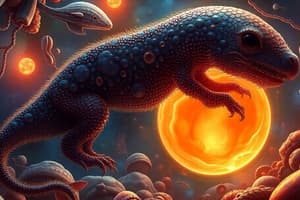Podcast
Questions and Answers
What is the dominant stage in animals' life cycles?
What is the dominant stage in animals' life cycles?
The multicellular diploid stage.
What is cleavage?
What is cleavage?
Cleavage is a series of rapid cell divisions without growth that converts the zygote into a ball of cells.
What is the name of the stage where the blastula undergoes invagination?
What is the name of the stage where the blastula undergoes invagination?
Gastrula.
What protist are animals most closely related to?
What protist are animals most closely related to?
What type of body did the Ediacaran biota have?
What type of body did the Ediacaran biota have?
Name the three germ tissue layers present in animals.
Name the three germ tissue layers present in animals.
What is hemolymph?
What is hemolymph?
What is the function of muscle tissue?
What is the function of muscle tissue?
What does the endocrine system regulate?
What does the endocrine system regulate?
What is the ideal value for a physiological parameter known as?
What is the ideal value for a physiological parameter known as?
Define negative feedback vs. positive feedback.
Define negative feedback vs. positive feedback.
Flashcards are hidden until you start studying
Study Notes
Animals: Development, Diversity, and Body Plans
Concept 32.1: Animal Development
- Multicellular diploid stage is the dominant stage in animals' life cycles
- Cleavage: a series of rapid cell divisions without growth that converts the zygote into a ball of cells
- Stages of development:
- Blastula: a hollow ball of cells
- Gastrula: a stage where the blastula undergoes invagination to form layers of embryonic tissues (ectoderm, mesoderm, endoderm)
Concept 32.2: Animal Origins and Diversity
- Animals are most closely related to choanoflagellates
- Ediacaran biota: ancient, mostly soft-bodied organisms from the late Precambrian
- Three hypotheses to explain the rise of Cambrian diversity and the decline of the Ediacaran biota:
- Predator-prey relationships: evolution of new predator species leading to diverse adaptations
- Increase in atmospheric oxygen: allowed larger and more metabolically active animals to thrive
- Evolution of Hox genes: led to developmental flexibility and new body plans
Concept 32.3: Body Plans and Symmetry
- Two types of symmetry found in animals: radial symmetry and bilateral symmetry
- Germ tissue layers present in animals: ectoderm, mesoderm, and endoderm
- Organs associated with each germ layer:
- Ectoderm: skin, nervous system
- Mesoderm: muscles, bones, circulatory system
- Endoderm: digestive tract, respiratory system
- Diploblastic animals have two germ layers (ectoderm and endoderm), while triploblastic animals have three germ layers (ectoderm, mesoderm, and endoderm)
- Coelom: a body cavity entirely within the mesoderm
- Hemocoel: a primary body cavity containing hemolymph (circulatory fluid in organisms with an open circulatory system)
- Acoelomates: animals without a coelom
- Molluscs have both a coelom and a hemocoel
Phyla of Animals
Porifera (Sponges)
- Lack true tissues and organs
Cnidarians
- Two body plans: polyp and medusa
- Gastrovascular cavity: a digestive system with a single opening (mouth) that serves as both entrance and exit for food and waste
Lophotrochozoans (Flatworms and Relatives)
- Most have bilateral symmetry
- Lophophore: a crown of ciliated tentacles used for feeding
- Platyhelminthes (Flatworms): flat bodies increase surface area relative to volume, facilitating diffusion of gas, waste, and nutrients
- Rotifers: have a form of asexual reproduction called parthenogenesis, where females produce offspring from unfertilized eggs
Molluscs
- Body plan consists of foot, visceral mass, and mantle
- Radula: a strap-like feeding structure
- True coelom: a body cavity entirely within the mesoderm
- Chitons: have eight overlapping dorsal plates
Annelids (Segmented Worms)
- Earthworms aerate the soil and decompose organic matter, enriching the soil
Ecdysozoans (Insects and Relatives)
- Tough external coat called a cuticle
- Process of shedding the cuticle called ecdysis
- Nematodes: unsegmented body, pseudocoelom, and a complete digestive system
- Arthropods: segmented body, exoskeleton, and jointed appendages
- Exoskeleton provides protection, support, and prevents water loss
- Open circulatory system: circulatory fluid (hemolymph) bathes the body cavity
- Three major lineages of Arthropods: Chelicerates, Myriapods, and Pancrustaceans
- Myriapods: Centipedes (one pair of legs per segment, carnivorous) and Millipedes (two pairs of legs per segment, detritivorous)
- Insects: development of wings, diversification of mouthparts, and coevolution with plants led to an explosion in evolution
- Metamorphosis: insects undergo either incomplete metamorphosis (nymph stages resemble adults) or complete metamorphosis (larval stages do not resemble adults and go through a pupal stage)
Echinoderms (Starfish and Relatives)
- Found in deuterostomia, along with chordates
- Water vascular system: a network of hydraulic canals used for locomotion, feeding, and gas exchange
Studying That Suits You
Use AI to generate personalized quizzes and flashcards to suit your learning preferences.




